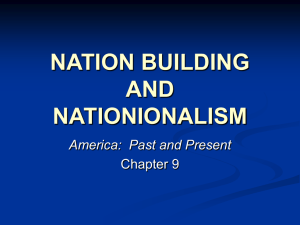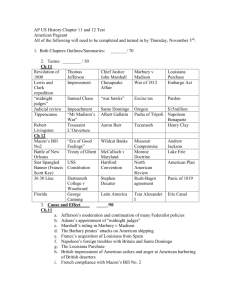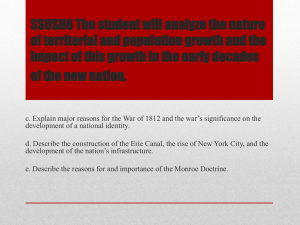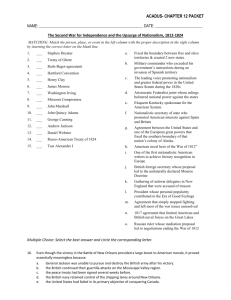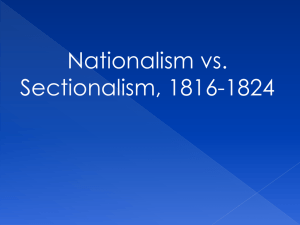Chapter 9 Summary - Biloxi Public Schools
advertisement
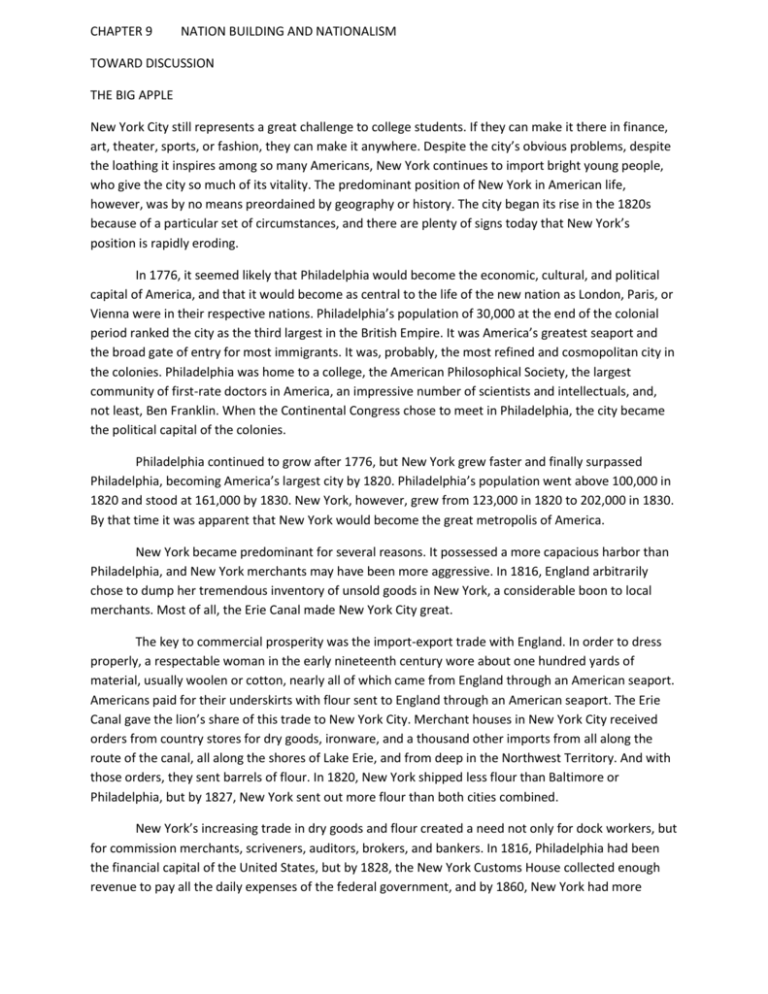
CHAPTER 9 NATION BUILDING AND NATIONALISM TOWARD DISCUSSION THE BIG APPLE New York City still represents a great challenge to college students. If they can make it there in finance, art, theater, sports, or fashion, they can make it anywhere. Despite the city’s obvious problems, despite the loathing it inspires among so many Americans, New York continues to import bright young people, who give the city so much of its vitality. The predominant position of New York in American life, however, was by no means preordained by geography or history. The city began its rise in the 1820s because of a particular set of circumstances, and there are plenty of signs today that New York’s position is rapidly eroding. In 1776, it seemed likely that Philadelphia would become the economic, cultural, and political capital of America, and that it would become as central to the life of the new nation as London, Paris, or Vienna were in their respective nations. Philadelphia’s population of 30,000 at the end of the colonial period ranked the city as the third largest in the British Empire. It was America’s greatest seaport and the broad gate of entry for most immigrants. It was, probably, the most refined and cosmopolitan city in the colonies. Philadelphia was home to a college, the American Philosophical Society, the largest community of first-rate doctors in America, an impressive number of scientists and intellectuals, and, not least, Ben Franklin. When the Continental Congress chose to meet in Philadelphia, the city became the political capital of the colonies. Philadelphia continued to grow after 1776, but New York grew faster and finally surpassed Philadelphia, becoming America’s largest city by 1820. Philadelphia’s population went above 100,000 in 1820 and stood at 161,000 by 1830. New York, however, grew from 123,000 in 1820 to 202,000 in 1830. By that time it was apparent that New York would become the great metropolis of America. New York became predominant for several reasons. It possessed a more capacious harbor than Philadelphia, and New York merchants may have been more aggressive. In 1816, England arbitrarily chose to dump her tremendous inventory of unsold goods in New York, a considerable boon to local merchants. Most of all, the Erie Canal made New York City great. The key to commercial prosperity was the import-export trade with England. In order to dress properly, a respectable woman in the early nineteenth century wore about one hundred yards of material, usually woolen or cotton, nearly all of which came from England through an American seaport. Americans paid for their underskirts with flour sent to England through an American seaport. The Erie Canal gave the lion’s share of this trade to New York City. Merchant houses in New York City received orders from country stores for dry goods, ironware, and a thousand other imports from all along the route of the canal, all along the shores of Lake Erie, and from deep in the Northwest Territory. And with those orders, they sent barrels of flour. In 1820, New York shipped less flour than Baltimore or Philadelphia, but by 1827, New York sent out more flour than both cities combined. New York’s increasing trade in dry goods and flour created a need not only for dock workers, but for commission merchants, scriveners, auditors, brokers, and bankers. In 1816, Philadelphia had been the financial capital of the United States, but by 1828, the New York Customs House collected enough revenue to pay all the daily expenses of the federal government, and by 1860, New York had more bankers than the rest of the nation. Success, of course, breeds success. The ancillary services that had grown up around the port of New York made the city even more attractive to shippers. New York became the great entrepot of the cotton trade. And just as cargo ships entered America by way of New York, so did immigrants. By 1830, New York received thirteen immigrants for every one that arrived in Philadelphia. It is hard to see how Philadelphia, with its air of refinement, could ever have become the capital of a society so inchoate, so pulsing, so vibrant as was early nineteenth-century America. New York was a better symbol of the new nation, but even New York failed to become the Paris of America. New York grew so large, so rich, so sophisticated, and so foreign, that the city soon appeared to most Americans, and to most New Yorkers as well, as a world apart. RELIVING THE PAST Lafayette was only one of the great number of foreign visitors who came to observe and report on America between the War of 1812 and the Civil War. Everyone realized that the United States was in the process of creating a new and different society. Nearly all Americans were optimistic about the results; Europeans, however, varied in their opinions, as indicated by the accounts of Charles Dickens and Frances Trollope. Dickens, with his ability to draw pictures in prose, gives a poignant description of the Eastern Penitentiary in Philadelphia, a humane attempt to reform criminals by placing them in solitary confinement. Dickens encountered a man who had lived in such confinement, in the same cell, for eleven years. When Dickens spoke to the prisoner, he remained silent, intent upon picking the flesh on his fingers. This can be found in Dickens’ American Notes. The 1968 Peter Smith reprint (Gloucester, Massachusetts) has a good introduction by Christopher Lasch. Barnaby Rudge is also interesting reading, especially those sections that deal with Barnaby’s sojourn in the United States. It is a good example of Dickens’ art in creating fiction out of his personal experiences. Frances Trollope threw a refreshing dose of cold water on everything American. Her description of a “literary” conversation in Cincinnati with a scholar who was too prudish to mention the title of Pope’s Rape of the Lock, and her description of the House of Representatives, its members wearing hats, spitting, and slouched in their seats, are amusing and insightful. They can be found in Frances Trollope’s Domestic Manners of the Americans. The most recent edition was published by Penguin Books in 1997. A REVOLUTIONARY HERO REVISITS AMERICA IN 1824 The author uses Lafayette’s visit to the United States to introduce a description of the great changes that had occurred in the fifty years since the Declaration of Independence. New lands were being opened to settlement, a transportation “revolution” was taking place, and a mood of confidence prevailed. EXPANSION AND MIGRATION After 1815 the American people shifted their attention from Europe and began to look westward. They saw a rich, unsettled continent, still held in part by the English, Spanish, and Indians. A. Extending the Boundaries John Quincy Adams, secretary of state from 1816 to 1824, deserves the most credit for expanding the nation’s boundaries during that period. Taking advantage of Spain’s decline, Adams negotiated two treaties: the Adams-Onís Treaty and the Transcontinental Treaty. Under the terms of these treaties, the United States secured all of Florida and reached as far as the Pacific. In terms of actual settlement, however, the “West” was still east of the Mississippi River. B. Native American Societies Under Pressure Almost 60,000 Indians lived in the southeast in 1815, most of whom had adopted a “civilized” way of life, including agriculture and slavery. Nevertheless, the United States government was determined to move them beyond the Mississippi River so that their land could be given to Whites. The Indians resisted in different ways. The Cherokees in a sense became more “White.” They wrote a constitution modeled on the United States Constitution, and adopted a written language. The Seminoles chose to take up arm and fought a series of “wars” with the United States army. Neither method was successful. C. Settlement to the Mississippi The land from which the Indians were evicted was sold by the government to large land speculators, who in turn sold the land in small parcels to actual settlers. By 1840 more than one-third of the nation’s population lived west of the Appalachians. Because so many settlers began their farming by being in debt, many immediately went into commercial farming and therefore needed access to markets. The trans-Appalachian West was dotted with small family farms tied to market towns and regional centers. D. The People and Culture of the Frontier The West was settled by immigrants who carried their cultures with them and who came to escape overpopulation, rising land prices, and worn-out soil. Since farming a new frontier meant starting with fewer tools and less available labor, cooperation and a strong sense of community became necessary for survival. The frontier farmer often saw his or her land shoot up in value in a few years. Many took the opportunity to sell out and move on, thus adding a touch of rootlessness to the frontier character. A REVOLUTION IN TRANSPORTATION Two important and interrelated developments marked this era: rapid improvement in transportation and the increasing use of money and credit in the economy. A. Roads and Steamboats In an effort to “conquer space,” the national government built the National Road, from Cumberland, Maryland, to Wheeling, then in Virginia. In addition, a whole web of turnpikes came into existence, built by private entrepreneurs. Usually, however, the roads did not return a profit, and, though beneficial to the public, they lost their attraction for investors. Nature blessed the United States with a network of rivers that constituted a natural transportation system that greatly encouraged America’s economic development. Flatboats carried cargo from the upper Mississippi and Ohio Valley to New Orleans, and all along the lower stretches of the great river, cotton planters built their wharfs. Flatboats traveled in only one direction, with the flow of the river, but, after 1811, steamboats churned the waters of the West and drove transportation costs down. The steamboat, actually less important than the flatboat, stirred a sense of romance in the American people. Congress even abandoned its usual hands-off policy toward private enterprise to regulate safety standards on the great paddlewheeler. B. The Canal Boom No river and no road linked East and West before the state of New York, led by Governor De Witt Clinton, built the Erie Canal between Albany and Buffalo. Even before its completion in 1825, the canal was an enormous success. Easterners and Westerners paid less for one another’s goods as a result, and New York City grew rapidly as a commercial center. Other states, such as Pennsylvania, Ohio, and Michigan also build elaborate canal systems. EMERGENCE OF A MARKET ECONOMY The revolution in transportation had a decisive effect on agriculture. Lower transportation costs meant greater income for the farmer. The sale of a farmer’s produce to distant markets meant participation in a complex system of credit. The greatest profits went to those who switched from mixed farming to a single crop. Agriculture in general became generalized by region. The Ohio Valley became a major wheat-producing area, but the most spectacular success was in the Deep South when it turned to cotton. Several factors were responsible, such as the invention of the cotton gin, increased demand, and the extensive use of slave labor. A. The Beginning of Commercial Agriculture Commercial farming and regional specialization demanded a new system of marketing. Farmers were less likely to sell their crops directly to the consumer. Instead, they sold their harvests to local merchants, who in turn sold the crops to regional merchants, who then sold to national or international traders. While farm products flowed in one direction, credit flowed in the other. Farmers were paid for crops before they were planted. The farmer, of course, paid interest on these loans, and the efficiency of the whole operation lowered total costs and increased profits for everyone. B. Commerce and Banking The greater use of credit stimulated the banking system. After 1812, the number of state banks grew rapidly, and as they competed to make loans, they made money easier and cheaper to obtain. Congress, fearful of a boom-bust economic cycle, created a second Bank of the United States in 1816 to check the irresponsible behavior of the state banks. Instead, the Bank of the United States added to the problem by making loans easy. In 1819, the nation suffered the inevitable collapse of its money supply. C. Early Industrialism Manufacturing increased after the War of 1812, but most manufacturing was still done at home; what changed was the way the process was financed. Merchants owned the raw materials, which they “put out” to farm families. Only in the textile industry did a fully developed factory system emerge. The most spectacular example was the complex operated by the Boston Manufacturing Company at Lowell, Massachusetts. The increasing success of industry in New England prompted business people in that area to shift their investments from shipping to manufacturing, and the politicians there began to pay more attention to ways in which government could aid industry. Even so, America was not yet an industrial nation; it was the growth of a market economy of national scope that was the major economic development of the period. THE POLITICS OF NATION BUILDING AFTER THE WAR OF 1812 Because the United States had a one-party system following the War of 1812, contending interest groups no longer took their differences into the political arena. Except for the Supreme Court, the national government became almost irrelevant to the domestic economy. A. The Republicans in Power Once the Federalists were out of the way, the Republicans did not need to follow a strict party line, and they even began to adopt Federalist measures. In 1815 and 1816, Republicans enacted high tariffs and established a national bank. Some Republicans, such as Henry Clay, wanted the national government to adopt measures that would have made the nation economically self-sufficient (the “American System”), but Presidents Madison and Monroe had constitutional scruples about federal aid going to internal improvements. In addition, grants for such improvements provoked sectional conflict. Congress retreated from its earlier attempts to stimulate economic growth, and even the National Road fell into disrepair. B. Monroe as President James Monroe was elected President in 1816 and re-elected in 1820. He was determined at all costs to preserve national harmony. When a major financial panic swept the country in 1819, Monroe did nothing to control it or to mitigate its effects, because he felt the president should stand above such matters. At the time, most Americans agreed. What is remarkable, however, is that Monroe provided no leadership in the controversy over Missouri. C. The Missouri Compromise The Missouri controversy arose when the Missouri territorial assembly applied for statehood in 1817. Missouri would be a slave state, and many Northerners already resented what they believed to be the South’s over-representation in the House of Representatives. James Tallmadge of New York persuaded the House to reject Missouri’s application unless it abolished slavery. The South considered Missouri’s admission crucial, because at that time there were eleven slave states and eleven free states. The South feared any change in this balance. Congress debated the issue in December 1819 and worked out a compromise. Missouri was allowed to become a slave state, but Maine was also allowed statehood as a free state. More important, Congress banned slavery from any part of the Louisiana Purchase (except for Missouri) above the latitude of 36°30'. Even more important, the Missouri controversy demonstrated a fundamental rift between North and South. D. Postwar Nationalism and the Supreme Court Between 1801 and 1835, John Marshall served as chief justice of the Supreme Court and used his position to encourage the growth of the nation. Because he believed that the Constitution existed to protect the industrious, whose exertions to enrich themselves would benefit the entire nation, he sought to protect individual property rights against government interference, especially from the state legislatures. In a series of decisions, Marshall limited the powers of the states, usually by holding them to a strict observance of contracts. E. Nationalism in Foreign Policy: The Monroe Doctrine When Spain’s colonies in Latin America rose in rebellion, the United States responded favorably toward the new nations. In Europe, however, the ruling classes feared that rebellion might prove contagious, and France was encouraged to squelch Spain’s rebellious colonies and, perhaps, to keep them for France. Neither Great Britain nor the United States would tolerate French involvement in Latin American affairs, and England asked the United States to cooperate in preventing it. John Quincy Adams persuaded President Monroe that the United States alone should guarantee the independence of Mexico and the states in South and Central America. In 1823, Monroe issued the Monroe Doctrine, warning European nations to stay out of the Western Hemisphere. The Monroe Doctrine had no real effect when it was first proclaimed, but indicated America’s growing self-confidence. In promising not to interfere in European internal affairs, America detached itself from worldwide struggles against tyranny and betrayed part of its revolutionary heritage. The shift of American focus from Europe to national affairs was one of the important themes of the period following the War of 1812. Americans now looked inward and liked what they saw. CONCLUSION: THE END OF THE “ERA OF GOOD FEELINGS” In its tremendous expansion, the United States developed a host of contending interests, many of which expected the government to favor them. The “era of good feelings” could not last.

